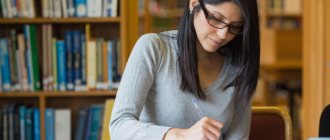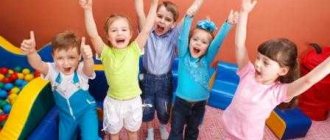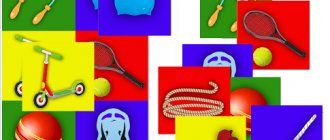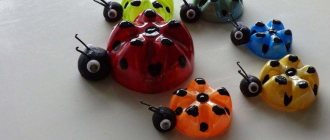Calendar and thematic planning “We are researchers” senior group.
1 half dayMorning of joyful meetings” Goal: To ensure the gradual entry of children into the rhythm of group life, to instill communication skills, love and respect for children and adults.
Morning exercises.
Ind. work according to with env. “What grows where?” Goal: consolidate knowledge about vegetables, fruits, berries.
Ind. work on FEMP “Mathematical coloring books”. Goal: to continue familiarization with geometric shapes.
Ind. work (Art), modeling “Pyramid”. Goal: to consolidate the ability to divide plasticine into pieces and create a composition.
Conversation “What is what?” Goal: to expand knowledge about wood and its properties.
Independent activity of children in activity centers.
Duty in the corner of nature, in the dining room, in classes.
Preparation for GCD
Walk.
Monitoring the operation of a bulldozer. Target :
expand your understanding of road technology.
Experimenting "Hot - Cold". Goal: To teach how to determine the temperature qualities of substances and objects.
P/i "Sparrows and cars". Goal: practice running without bumping into each other.
Ind. slave. according to Fizeau “Who will throw the snowball next?” Tasks: perform basic movements correctly, determine the winner of the competition, acting as judges and coaches with (Misha S., Misha K., Sasha Gund.)
D/ game “Echo”. Purpose: to teach to listen carefully and repeat only after a signal.
Games with external material (scapulas) Purpose: to develop the ability to play in small groups, to come up with game situations on your own.
Work before bed
:
Improve the skills of making the bed, the ability to carefully cover the bed with a blanket.
Didactic exercise “Who will make the bed correctly and quickly.”
2 half day.
The study “Music or Noise?” Goal: To teach to determine the origin of sound and distinguish between musical and noise sounds.
Playing material: Metallophone, balalaika, tube, xylophone, wooden spoons, metal plates, cubes, boxes with “sounds” (filled with buttons, peas, millet, feathers, cotton wool, paper, etc.).
Progress of the game: Children examine objects (musical and noise). The adult finds out together with the children which of them can make music. Children name objects, make one or two sounds, listening to them. An adult plays a simple melody on one of the instruments and asks what song it is. Then he finds out whether the song will work if he just knocks on the tube (no); what to call what happens (noise). Children examine boxes with “sounds”, looking into them, and determine whether the sounds will be the same and why (no, since different objects sound differently). Then they extract a sound from each box, trying to remember the noise of different boxes. One of the children is blindfolded, the rest take turns making sounds from objects. A blindfolded child must guess the name of a musical instrument or sounding object.
Theatrical activity. Magnetic theater "Morozko" Goal: To help children remember the fairy tale better, to create a desire to reproduce dialogues between fairy-tale characters (introduction to theatrical play). To develop in children the ability to listen carefully to a fairy tale; cultivate the ability to empathize with heroes and imitate; coordinate your actions when conducting a simple staging.
S/r game "Repair Shop". Goal: formation in children; interest in gaming activities, collective activities.
Drawing "Winter's Tale". Goal: learn to draw trees.
D/game “What happens in winter.” Target. Reinforce the signs of winter.
Ind. work (FEMP) “Magic wands”. Goal: to practice drawing geometric figures on the plane of the table, analyzing and examining them in a visually tangible way.
Independent play activity by design. Goal: learn to play in small groups according to independent plans.
Walk 2.
Stargazing. Goal: talk about the stars.
P/game “At the bear in the forest.” Goal: practice running without bumping into others.
D/game “Add a word.” Target :
practice selecting words that are similar in consonance.
Ind. slave. "Confusion". Goal: consolidate the names of body parts.
Ind. slave. according to Fizeau “Step wider!” Purpose: practice marching.
Ind. slave. on familiarization with the surrounding “What is what”. Goal: consolidate knowledge.
Work. Clearing paths covered with snow. Target. Learn to use a shovel correctly and finish what you start.
Ind. slave. according to Fizeau “Who will throw the snowball next?” Tasks: perform basic movements correctly, determine the winner of the competition, acting as judges and coaches with (Misha S., Misha K., Sasha Gund.)
Games with external material. Purpose: to develop the ability to play in small groups, to come up with game situations on your own
Lesson on cognitive and research activities in kindergarten
Cognitive and research activity is one of the spontaneous manifestations of a child’s curiosity. This quality of an inquisitive mind must be actively involved in a variety of classes: studying the surrounding world, productive (drawing, modeling, designing), preparing for literacy, etc. Exclusively research activities occupy a small part in the educational process, sometimes they are separated into club activities (work in mini-laboratories, experimental workshops). The teacher should practice conducting integrated classes in which work is carried out in several directions (“artistic and aesthetic development”, “cognitive activity”, “labor activity”, etc.), paying maximum attention to the formation and improvement of research skills when studying by children objects and phenomena of the surrounding world.
After directly studying the vegetables, the children can draw them
Table: card index of topics for educational and research activities
| Research topic | Tasks | Age group |
| "Water and its properties" |
| Junior |
| "Magic Sponges" |
| Junior |
| "Lemon" | Formation of the ability to conduct research in various ways: visual, olfactory, kinetic. | Junior |
| “I'm a researcher. Stone" |
| Junior |
| “Why did the snowman melt?” |
| Average |
| "Milk" |
| Average |
| "Lost and found" |
| Average |
| "Amazing Ball" | Formation of ideas about the properties of rubber in the process of research activities. | Average |
| "Merry vegetable garden" | Expanding knowledge about cultivated plants and methods of growing them. | Average |
| "Energy. Current runs through the wires" |
| Older |
| "The Amazing Magnet" |
| Older |
| "Pillow" | Development of the ability to compare, generalize and draw conclusions (using the example of studying pillows with various fillings - synthetic winterizer, cotton wool, fluff, buckwheat husk, straw). | Older |
| "Volcano" | Improving the ability to work with various materials and substances during the experiment. | Older |
| "Worms" |
| Older |
| "Salt" | Formation of ideas about the properties of salt (including salt water) and their use in production and everyday life. | Preparatory |
| "Thermometer" |
| Preparatory |
| "The Diver from Komarovo" | Formation of ideas about the floating of bodies, air pressure and liquids. | Preparatory |
| "Human Pupil" | Acquaintance with the properties of the pupil to expand and contract depending on lighting. | Preparatory |
Table: lesson notes on cognitive and research activities in the senior group (fragment)
| Author | Zakharova E., teacher of MBDOU D/s No. 8 “Cheburashka”, Belaya Kalitva, Rostov region. |
| Subject | "Volcano" |
| Target | Introduce children to a natural phenomenon - a volcano. |
| Tasks |
|
| Materials |
|
| Progress of the lesson | Motivation. V.: Guys, today the postman brought us a parcel. Are you interested in knowing what's in it? (They open it, there is pumice there). Who knows what this is? What is the name of? What is it for? Maybe someone has such an item at home? (Children's answers). Preschoolers examine pumice and compare it with the rocks already available in the experimentation corner: coal, chalk, sandstone. V.: There is also a note in the parcel, and there is a hint in it, listen:
But this object does not look like a volcano at all. This hint did not help us, but, on the contrary, confused us. Guys, are you interested in knowing what this item is? Then we will try to find out. We will also find out what a volcano is and how it is connected to the mystery object. The teacher tells the children a legend about the volcano. <,…>, V.: Now do you want to see what a real volcano looks like? (Children's answers). Our computer will help us. (Show slides with different types of volcanoes: “sleeping”, “waking up”, “boiling”, erupting). Volcanoes erupt in different ways. Sometimes they seem to explode, throwing magma up and to the sides. A huge mountain shakes with a terrible roar, a huge cloud of smoke and ash rises above it, and stone rain showers the slopes. And sometimes it flows out “calmly.” What does a volcano look like? (A volcano is a large mountain with steep sides). What shape is the volcano? (Cone). At the very top of the volcano there is a crater. The crater is a huge bowl with steep slopes, and at the bottom there is a reddish-orange mouth, this is the mouth of a volcano, a hole going deep into the ground. The fiery liquid coming out of a volcano is called lava. Interesting? Do you want to see a volcanic eruption? I suggest you do an experiment: a volcanic eruption. Where can you do experiments? (In the laboratory). I suggest you go to our laboratory of “interesting discoveries” (they go to tables with volcano models prepared in advance and all the necessary components for the experiment). In our laboratory, everything is ready to conduct experiments. What will we make the base of the volcano from? (From the cone). What is a volcano's mouth made of? (A plastic cup). All this is on a tray. Before you begin the experiment, you need to study the diagram. (The teacher, together with the children, discusses the sequence of the experiment.)
What are you observing? Watch your volcano erupt. It erupts calmly. <,…>, Guys, can we show a volcanic eruption? Shall we try? Sketch “The volcano wakes up and erupts.” V.: Guys, you and I did the “Volcanic Eruption” experiment, and I told you the legend about the volcano, and we learned the structure of the volcano, and even depicted the volcano ourselves... But they forgot a little about our mysterious object, what it is after all ? Maybe someone figured it out after all? (Children's answers). And if we don’t know something, who or where can we find out? (Encyclopedia, reference book, on the Internet). Do we have an encyclopedia in the library? Let's see if there is an answer to our question. We open it and read: this is pumice - frozen volcanic lava. Used to remove dirt from hands or rough skin from heels. Questions for reflection:
V.: I’m glad that you really liked it, and you were so attentive, active, inquisitive, great fellows! |
| Quote from: https://www.maam.ru/detskijsad/konspekt-zanjatija-poznavatelno-isledovatelskaja-dejatelnost-vulkan-starshaja-grupa.html | |
Lesson time plan
The duration of educational classes in kindergarten depends on the age of the students and is determined by SanPiN standards:
- junior group - 15 minutes,
- middle group - 20 minutes,
- senior group - 25 minutes,
- preparatory group - 30 minutes.
In the middle of the lesson, physical education or an active game should be carried out as a means of preventing overwork.
Since cognitive-research activities require mental effort, they should be conducted in the first half of the day, preferably on Tuesday or Wednesday - days of high performance.
Table: time plan for the lesson “Visiting the Paper Fairy” in the younger group
| Structural component of the lesson | Motivating start (surprise moment) | Didactic game | Physical education minute | Study of paper properties | Summarizing |
| Time spending | 2 minutes | 2–3 minutes | 1–2 minutes | 7 minutes | 1–2 minutes |
Table: time plan for the lesson “Journey to the World of Water” in the middle group
| Structural component of the lesson | Motivating start (creating a game situation, solving riddles) | Didactic game | Outdoor game | Studying the properties of water (conducting experiments) | Summarizing |
| Time spending | 2–3 minutes | 3 minutes | 3 minutes | 10 minutes | 1–2 minutes |
Table: time plan for a lesson during a walk “Why do icicles cry?” in the senior group
| Structural component of the lesson | Motivating beginning (reading and discussion of a didactic fairy tale) | Charging outdoors | Research (observation of icicles in the shade and in the sun) | Work assignments | Conducting an experiment with ice floes | Summarizing |
| Time spending | 3–4 minutes | 5 minutes | 10 minutes | 5–7 minutes | 4 minutes | 2 minutes |
Table: time plan for the lesson “What is a rainbow?” in the preparatory group
| Structural component of the lesson | Motivating beginning (surprise moment, problematic situation, watching a video) | Heuristic conversation | Outdoor game | Didactic game | Studying the conditions for the appearance of a rainbow (conducting an experiment) | Summarizing |
| Time spending | 3 minutes | 3–5 minutes | 3–4 minutes | 3 minutes | 12–14 minutes | 1–2 minutes |
Analysis and diagnosis of cognitive and research activities
To evaluate the results and effectiveness of students’ cognitive and research activities, the teacher conducts diagnostics according to the following criteria:
- ability to formulate problems for students,
- correct formulation of questions,
- building an action algorithm to solve the problem,
- putting forward hypotheses,
- choice of research methods,
- ability to describe observations during the research process,
- presence of thinking skills (analysis, comparison, generalization, systematization),
- degree of independence at each stage of the research,
- ability to make inferences, conclusions, summing up.
A high level of cognitive and research activity is evidenced by the presence of stable motivation to solve problem situations and search for answers to posed questions, independent construction of a research algorithm and carrying out practical work (experiments), competent formulation of the information obtained, and correct drawing of conclusions. A child with a developed research type of thinking takes the initiative in choosing materials and tools for conducting observations, is not afraid to put forward hypotheses and test them experimentally, and brings what he starts to the end in order to obtain compliance with the voiced hypothesis or refute it.
Future researchers are not afraid to put forward hypotheses and test them experimentally
To identify the attitude of pupils towards experimental activities and determine the level of mastery of research skills, the teacher can invite children to keep a special journal in which preschoolers record the results of the work done. At the same time, it is recommended that the teacher keep diagnostic cards for each student, in which he enters data from his own observations of the children’s research activity.
Planning cognitive and research activities in different age groups of preschool educational institutions.
Thus, in the course of cognitive research activities, various forms of work with children are used, which are aimed at developing children’s cognitive activity, interests, and self-realization.
Chapter II . Methodology for planning cognitive and research activities in different age groups of preschool educational institutions
2.1. Features of cognitive and research activities of preschool children in different age groups
When organizing educational and research activities, it is necessary to take into account the age characteristics of children of different groups.
The cognitive and research activity of preschoolers at the first stage of its implementation in the junior and middle groups is formed at the imitative-performing level. Lack of life experience and insufficient level of development of intellectual and creative abilities do not allow the child to fully exercise independence in choosing a problem and solving it - here an active role belongs to an adult. In joint activities with an adult, the child masters methods and techniques of action, learns to act independently, taking into account growing capabilities, and strives to achieve a better result. In early preschool age, cognitive and research activities are aimed at objects of living and inanimate nature through the use of experiences and experiments. Experimentation is carried out in all areas of activity: eating, studying, playing, walking, sleeping, washing. Experimentation is carried out both in class and in free independent and joint activities with the teacher. Thanks to experiments, children compare, contrast, draw conclusions, express their judgments and conclusions. For example, a series of experiments are carried out with children to familiarize themselves with the properties of water and snow, which allows them to form a differentiated understanding of living nature and their relationship.
In the middle group, children are introduced to the transition of bodies from one state to another (water-ice-water), and are shown the relationship between living and inanimate nature. Objects of inanimate nature are studied: sand, clay, snow, stones, air, water, magnet, etc. In the middle group, they experiment with mixing paints to obtain new colors, study plant seeds, tree bark, vegetables and fruits, learn the properties of snow and stones , plasticine, dough.
By the senior preschool age, cognitive-research activity is isolated into a special activity of the child with its own cognitive motives, a conscious intention to understand how things work, learn new things about the world, and streamline one’s ideas about any area of life. The cognitive-research activity of an older preschooler in a natural form manifests itself in the form of so-called children’s experimentation with objects and in the form of verbal exploration of questions asked of an adult (why, why, how?). Cognitive-research activity gradually becomes more complex, more attention is paid to the independence of children in this activity .



